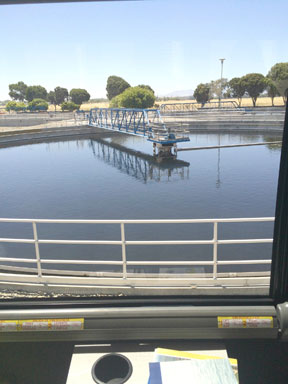

In spite of the faint odor outside the administration building of the San Jose-Santa Clara Regional Wastewater Facility possibly coming from the facility or neighboring landfills, visitors of the June 25 public tour were eager to learn what happens to contents flushed down toilets and washed down sinks. Inside the building, visitors received complimentary fat scrapers to scrape fats, oil or greasy scraps to be transferred to the garbage can (from the pan to the can) to prevent sewage backups from sink disposal. In about one hour, visitors gained insights about the San Jose-Santa Clara Regional Wastewater Facility, owned by the City of San Jose and the City of Santa Clara.
“The San Jose-Santa Clara Regional Wastewater Facility is about 60 years old; it was built in 1956,” says Jennie Loft, City of San Jose’s public information manager in the Environmental Services Department. “The tour is an opportunity for the community to learn about how wastewater is treated and how it impacts the environment nearby as well as learn about the rebuilding of the facility with the $1.5 billion capital improvement program.”
First, operations superintendent Michael Tocalino gave a short lecture in the conference room. He briefed attendees on the eight steps that incoming wastewater undergoes before it leaves the facility as clean water. Daily, about 100 million gallons of treated clean water, formerly wastewater, is discharged from the facility into the Artesian Slough, where it flows through Coyote Creek and then into the South San Francisco Bay. Also, daily, around 10 million gallons of the clean water goes to South Bay Water Recycling, which provides recycled water to businesses for industrial and irrigation purposes. Tocalino emphasized that this facility does not convert wastewater into drinking water.
“We serve eight cities in four special districts; those are San Jose, Santa Clara, Milpitas, Cupertino, Campbell, Los Gatos, Monte Sereno and Saratoga,” Tocalino says. “We treat 110 million gallons per day. It’s a 24/7 operation. There’s around [300 employees] for the facility. We’re talking about operations, engineers, mechanics, electricians, chemists, biologists, analysts, technicians, computer technicians and other support staff.”
While riding in the packed tour bus, visitors spotted facility equipment — old pipes, storage tanks and digesters — that will be replaced using capital improvement funds. “Anybody know when our largest peak flows arises?” asks Carolina Camarena, senior public information representative, as the bus passed by the headworks where giant screens separated refuse from incoming wastewater. “One time a year: half time at Super Bowl. Or ten hours after Super Bowl half time.”
The bus also passed a clarifier, a large round pool filled with water.
“This is part two of the secondary treatment process,” Camarena says. “This holds 1 million to 1.5 million gallons of water. This is a clarifier tank. We’ve slowed the flow and are letting water settle for one to three hours to let the bacteria sink to the bottom so we can remove it from the water.”
At the end of the tour, a visitor asked about how prescription drugs flushed down toilets effected the treatment of wastewater. According to Camarena, most wastewater treatment facilities across the nation don’t remove medications, and so the chemicals in these medications end up in the ocean. Therefore Camarena encourages people to learn to dispose of their medicines correctly by going to hhw.org or by participating in a prescription takeback program (the Santa Clara Police Department offers a medication drop off program).
Susan Anderson Chen attended the tour with her husband, Art.
“I do a lot of hiking and as you do that, you get interested in water sheds and where that water goes,” Chen says. “I’m also interested in wildlife habitats. Today I learned that wastewater treatments help to make natural habitats safer for animals, fish and birds.”

